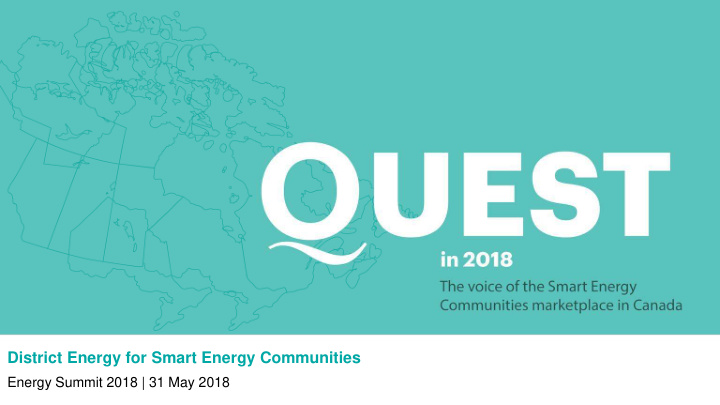



District Energy for Smart Energy Communities Energy Summit 2018 | 31 May 2018
AGENDA 1. Smart Energy Communities Overview 1. District Energy Systems Overview a. What is DE? b. DE in Canada c. Opportunities 1. Engaging with District Energy a. Customer (Energy end-user) b. Producer (Energy source) c. Owner / Operator (Both energy end-user and source)
ABOUT QUEST > As the voice for the Smart Energy Communities marketplace, QUEST offers a national network of working groups where participants interested in energy related issues can meet, exchange information, communicate success stories, advance implementation strategies and develop partnerships. > QUEST supports governments, utilities & energy service providers, the real-estate sector, and the product and professional service sector, among others to make Smart Energy Communities come to life. 3
SMART ENERGY COMMUNITIES
SMART ENERGY COMMUNITIES ● Communities across Canada are increasingly engaged as Smart Energy Communities to: ○ Decrease GHG emissions ○ Enhance economic development and cut costs ○ Improve reliability ○ Increase energy efficiency ● Thermal energy (i.e. for heating/cooling) is a significant component of community energy planning ○ Space heating, water heating, and space cooling for residential, commercial and institutional buildings in Canada account for: ■ 22% of energy use (over half a million GWh) ■ 19% of GHG emissions (over 90 Mt CO 2 e)
DISTRICT ENERGY SYSTEMS District Energy Systems (AKA ‘thermal networks’ or ‘thermal grids’): “ a network of underground insulated pipes that pump hot or cold water to multiple buildings in a district, neighbourhood or city . Some systems just connect a few buildings, while others connect thousands of buildings and homes across a city”* Enabling infrastructure for: ● Increasing energy efficiency ● Harnessing local/renewable energy opportunities ● Enhanced resilience *United Nations Environment Programme’s District Energy in Cities Initiative
DISTRICT ENERGY IN CANADA Recent interest at all levels of government, including: Federal Government ● 2018 Budget expanded accelerated deductions for DE equipment (as well as feasibility/pre-feasibility studies) ● Northern Responsible Energy Approach for Community Heat and Electricity (REACHE) program Provincial Governments ● Ontario’s Long-Term Energy Plan highlights district energy Local Governments ● Over half of Community Energy Plans in Canada mention district energy
DISTRICT ENERGY IN CANADA (Canadian Energy and Emissions Data Centre)
DISTRICT ENERGY IN CANADA (Canadian Energy and Emissions Data Centre) ● 157 facilities reported across Canada ● Many natural gas facilities utilizing combined heat and power (CHP), and increasingly renewables
OPPORTUNITIES Improve overall efficiency ● Promotes ‘energy cascading’ (i.e. utilization of waste heat to optimize fuel use) Outsource energy supply and equipment ● Enhanced reliability and reduced O&M needs ● Reduced floor space requirements ● Can spread capital costs ● Can mitigate energy cost volatility (including carbon-pricing) Tap into local energy opportunities ● Efficiencies of scale may make certain opportunities (ex. Waste heat, biomass, geothermal, waste-to-energy) more cost effective
ENGAGING WITH DISTRICT ENERGY District energy (DE) broadly encompasses an approach to distributing thermal energy Potential roles for industry players: ● Customer (Energy end-user) ● Producer (Energy source) ● Owner / Operator (Both energy end-user and source)
CUSTOMER CASE STUDY EXAMPLE Markham District Energy Inc., Markham, ON • Prominent customers: IBM Canada, Bell Canada, Markham Stouffville Hospital Energy Efficiency and Reliability • Combined heat & power at ○ 99.998% heating reliability ○ 99.997% cooling reliability Renewable Energy • Piloting algae-based biomass integration with Pond Technologies
PRODUCER Strathcona and Heartland Industrial Areas, Alberta ● Energy mapping study found: ○ 17 industrial sites had collectively 300 MW of sensible waste energy, some located near to potential new development area ○ Data templates developed to calculate potential waste heat* CASE STUDY EXAMPLE Göteborg Energi, Gothenburg, Sweden ● Established on waste-to-energy + waste heat from industry ○ Now integrates biomass + river (and absorption) cooling *http://cmcghg.com/wp-content/uploads/2015/02/Integrated-Energy-Mapping-Study_FINAL-REPORT.pdf
OWNER / OPERATOR CASE STUDY EXAMPLE TELUS Garden Office Tower, Vancouver • Collaboration with Fortis BC Alternative Energy Solutions Energy Efficiency and Reduced GHG Emissions • Waste heat recovery from TELUS Data Centre ○ Energy demand reduction of 80% ○ Reduction of >1M kg CO 2 e/yr Also connected to Creative Energy for peaking and resiliency
MICHAEL LEE SENIOR LEAD, ANALYTICS & SERVICES mlee@questcanada.org
Recommend
More recommend